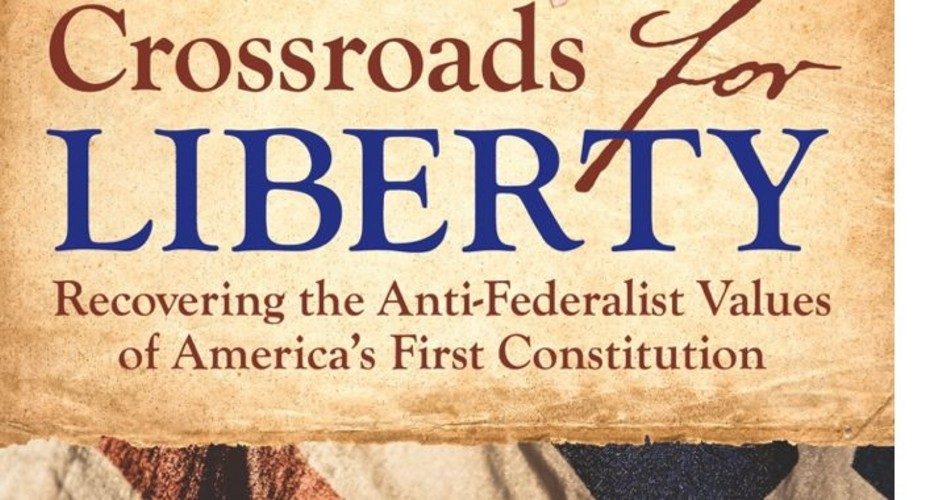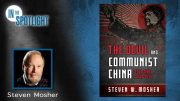
At best, the coverage that the Articles of Confederation receives in an American History class is sketchy. At worst, if anything much is said about America’s “first Constitution,” it is uniformly negative, along the lines of “it was just too weak a central government, it accomplished nothing, but thankfully, we scrapped the Articles, and replaced that document with the Constitution.”
In his insightful book Crossroads for Liberty, however, author William J. Watkins rescues the Articles from obscurity and condemnation. He does not argue that the Articles constituted a perfect system, but it was a far better system than has been portrayed in the history books — a fact that some of the Founders would have agreed with.
When told the Articles of Confederation had created a hopelessly weak common government for the United States, and should be replaced, Patrick Henry shot back that its government had put an army in the field for seven years, one that had defeated the mighty British Empire. He warned that ditching the Articles for the Constitution would lead to an increasingly centralized government, one that would eventually leave us with weak states dictated to by that centralized government.
The very reason that the patriot leaders of America seceded from the British Empire was they did not want some far-off government telling them what to do concerning local matters. They adopted the Articles of Confederation, which were designed to let the people of each state govern themselves, while forming an alliance to maintain their independence. The Anti-Federalists, who wished to keep the Articles, with amendments, held to the view as expressed by Baron de Montesquieu of France, who said, “It is natural to a republic to have only a small territory; otherwise it cannot long subsist.” The solution, as they saw it, was a confederation.
The Federalists, on the other hand, believed the Constitution, with its federal system of government could accomplish the same thing, without the deficiencies they saw in the Articles. This system of dual sovereignty, championed by men such as James Madison, was rejected by an anonymous Anti-Federalist, calling himself Centinel. Speaking of the idea of “two co-ordinate sovereignties” existing together, Centinel wrote in 1787, “You must separate the sphere of their jurisdiction, or after running the race of dominion for some time, one would necessarily triumph over the other.” Watkins writes, “Based on the broad powers granted to Congress, Centinel predicted that the federal government” would ultimately prevail.
Anti-Federalists’ Concerns About the Constitution
Watkins reviews the prophecies of the Anti-Federalists, citing their concerns, specifically such provisions as the general welfare clause, the commerce clause, the necessary and proper clause, the designation of the president as “commander-in-chief” of the armed forces, the role of the judiciary, and the treaty-making power.
Their concerns have certainly proven legitimate. For example, Alexander Hamilton, writing in Federalist, No. 33, argued the “necessary and proper clause” was “perfectly harmless.” Madison expressed similar views in Federalist, No. 44. But it would not be too many years before Madison would see this clause be used to create the First Bank of the United States. Watkins notes, “Congressman James Madison was shocked … [saying that] the construction put forward [to create the Bank through the necessary and proper clause] would destroy the system of enumerated powers crafted in Philadelphia.” It is likely that even Hamilton would likewise be shocked at how the necessary and proper clause has been stretched beyond recognition to expand the powers of the central government.
While the Constitution explicitly placed the power to declare war in the hands of the legislative branch, the Anti-Federalists expressed concern that the president would slowly take over this power, using his designation as “commander-in-chief” of the armed forces. Watkins notes that while it appeared for most of American history that their concern may have been overstated, presidents since 1950 have proven them prescient.
Among the more interesting parts of the book is Watkins’ analysis of what the two sides thought of the federal judiciary. “Brutus” was an Anti-Federalist who stepped up to challenge the creation of federal courts. “Brutus was troubled by the constitutional provision whereby judges hold office during good behavior,” Watkins noted. Brutus was not so concerned about judges ruling on the meaning of the Constitution, Watkins says, but he did argue, “Unelected judges serving for good behavior would, as a practical matter, have the final say on the Constitution, statutes, and most disputes.” (Emphasis added.)
“Brutus did not argue with the necessity of judicial review. His concern was with judicial supremacy,” Watkins wrote. “Under the Constitution,” Brutus complained, the judges “are independent of the people, of the legislature, and of every power under heaven. Men placed in this situation will generally feel themselves independent of heaven itself.”
When one considers the Supreme Court decisions “legalizing” so-called same-sex “marriage,” and abortion on demand, it appears that Brutus had the accuracy of an Old Testament prophet.
After examining these and many other examples of the legitimate fears of those who wished to keep the Articles of Confederation, Watkins turns to the question of what now can be done. We certainly cannot return to the Articles — unfortunately, we cannot even return to the Constitution — at least not as it was intended to work by its framers. “Experience is a great teacher and shows that the fears articulated about aspects of the Constitution of 1787 were not speculative.”
The Anti-Federalists and the Federalists alike understood that human nature was flawed, and needed, in Thomas Jefferson’s words “the chains of the Constitution.” Watkins urged his readers, “Their principles can guide us back to stability and limited government. Let us open our ears and hear what they have to say.”
What Do We Do Now?
Watkins offers various suggestions, based on those principles. “Yes, from Parliament’s imposition of the Stamp Act to the fight over Obamacare, the debate has focused on the division of power between the colonies/states and the general government of the empire/union.” Watkins quotes Chief Justice John Marshall, who predicted in 1819 that “the question respecting the extent of the powers actually granted [to the Union] is perpetually rising, and will probably continue to arise so long as our system shall exist.”
Watkins offers some interesting ways to mitigate this rise in national power. He believes our present system of limiting the House of Representatives to only 435 member (as it has since the 1920s) is detrimental to limited government. As the number of constituents a representative must have grows, as the population expands, these representatives become increasingly disconnected with the very people they are supposed to be representing.
Whether this or some other suggested amendment is good or bad, how should the Constitution be changed? The Anti-Federalists did not think highly of the system of amending the Constitution, as written in Article V of the Constitution. One, calling himself, “An Old Whig” observed that people “once possessed of power are always loathe to part with it; and we shall never find two thirds of a Congress voting or proposing anything which shall derogate their own authority and importance, or agreeing to give back to the people any part of those privileges which they have once parted with.” The so-called “Federal Farmer” agreed with Old Whig, arguing that Congress would “be exceedingly artful and adroit in preventing any measures” in limiting national power.
But Federalist Wilson Carey Nicholas countered, arguing, “There is another mode provided, besides that which originates with Congress.” Nicholas “touted” the convention procedure of Article V in which states could force a constitutional convention. Watkins agrees that outside the first 10 amendments, which were ratified in 1791, “constitutional amendments (for the most part) have augmented national power rather than curtailed it.”
But Watkins does not favor a national convention, as provided for in Article V. “There never have been enough states requesting a convention and this is for good reason. First, no one knows whether such a convention would be limited or unlimited in its scope. If the states requested a convention to consider proposing a balanced budget amendment, would the convention be prohibited from also offering amendments on matters such as abortion or capital punishment?”
Watkins then cites the language of Article V: “Congress … on the application of two-thirds of the Legislatures of the several States, shall call a convention for proposing amendments,” noting, “The plain language at the end of the sentence seems to suggest that a convention would be unrestricted and could propose amendments on a variety of subjects.”
Watkins adds, “A convention could result in much chaos and constitutional uncertainty.”
“On paper,” Watkins laments, “they [the states] could demand a convention, but in reality Congress holds all the cards when it comes to constitutional change.”
Instead, Watkins argues that “the states need the ability to propose and consider amendments without the involvement of the national legislature or the risks associated with a convention.” Watkins proposes that any state should be able to propose a constitutional amendment, and if the originating states can then persuade three-fourths of the others to ratify, then it should become a part of the Constitution. This has the effect of restoring power to the states.
All in all, Watkins has produced a thought-provoking book, one that would make a good addition to the library of any American who favors liberty and limited government.
Crossroads for Liberty: Recovering the Anti-Federalist Values of America’s First Constitution, by William J. Watkins, Jr., Oakland, California: Independent Institute, 2016, 313 pages, hardback.



